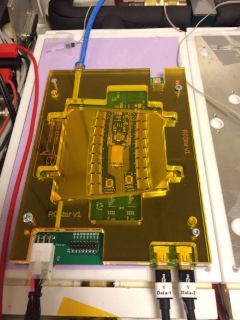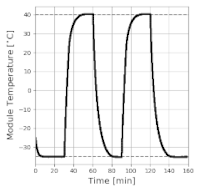Alexander Ekman
Doctoral candidate

Doctoral project
ATLAS detector upgrade and trigger level analysis
I’m a particle physic PhD student from Lund university. In Lund I work with Caterina Doglioni on the Trigger Level Analysis, a data analysis in the search for new physics and dark matter at the Large Hadron Collider (LHC) at CERN. Within the framework of the HELIOS graduate school I’ve also recently been able to come to DESY and work with Sergio Diez Cornell on developing the quality testing and quality assurance system for the new ATLAS inner tracker (ITk) detector modules.
At a large experiment like the ATLAS experiment there are many instrumental challenges. One challenge that spans both detector hardware, data acquisition, and analysis for the foreseeable future is that we want to make efficient use of the millions of proton collisions provided by the Large Hadron Collider… every second.
This is an instrumental challenge that gets more difficult as accelerator technology advances. In 2027 the High-Luminosity LHC will be finished, which will provide 10 times higher luminosity (measure of events per cm 2 per second). The instrumental challenge with this upgrade is that we get more events per second, more data per event, more difficult data to analyse, and more radiation.

Inner Tracker Upgrade (ITK)
One of the HELIOS projects working on this instrumental challenge is the upgraded inner tracker. The tracker at ATLAS detects the trajectory of charged particles in 3D space from the collisions. Which is absolutely vital for determining particle identity and momentum. Due to the higher luminosity of the High Luminosity LHC, the ITk will need higher readout speeds, higher spatial resolution, and higher resistance to radiation damage. Some of the detector modules designed to battle this instrumental challenge will be assembled at DESY and quality tested at both DESY and Lund, as well as multiple other institutes.
Within the framework of the HELIOS graduate school, I was able to spend 2 fantastic months at DESY, where I got involved in a hardware project to develop a quality testing system for the new detector modules. In the tests that we are developing, we are looking at the modules’ noise levels and physical durability as we cycle them through -35 ℃ and +40 ℃ multiple times.

During my 2 months at DESY I developed a temperature control and automated thermal cycling using a raspberry pi microcontroller. As you can see in the figure cycling between 35 ℃ and +40 ℃ worked very well. The Controller was able to cycle the temperature multiple times and keep the temperature stable at each target temperature for at least 10 min.
However, temperature control is just the tip of the iceberg for the coldbox project. Coldboxes will be produced and distributed by DESY to roughly 20 other institutes which will do module testing. The difficult part for me is that the control and monitoring software should work for everyone and be easy to implement with any kind of power supplies, chillers, temperature sensors etc. Because of this, the project is actually a proper product development project, where we have to deliver a working system to users all over the world.
Because of this I am very excited to meet the HELIOS partners in industry, which work with product development and delivery on a daily basis. I am looking forward to seeing what things we can learn from these companies and what they can learn from us in hardware development but also in analysis.
Trigger Level Analysis
Just like many analyses at ALTAS, our analysis wants to explore new areas of our phasespace in the search for new physics, such as dark matter. One way to push the boundaries of our un-explored phase space is to obtain more data. Since we can only keep a fraction of the collision events delivered by the LHC, we want to keep those that are interesting. For this job we use what is called a trigger. Much like you press the camera trigger when you see something interesting worth keeping, the ATLAS trigger looks at the collision events, but only keeps the interesting ones.
This is where our analysis has a trick. The problem is not the amount of events per second, the problem is the data size per second. What our Trigger Level Analysis does, is that it uses the partially reconstructed events from the trigger to obtain a lot more events. This is possible because these partially reconstructed events are less than 1% the size of fully reconstructed events. This allows TLA to obtain almost twice the amount of events for a

Outlier Detection
Trigger Level Analysis, like many other analyses looking for new physics is interested in outlier detection. In general terms, outlier detection is the identification of rare events which raise suspicions by differing significantly from the majority of the data. In our specific case dark matter event at the LHC will also be a very rare event, and we might not be prepared for how it will look like. It is therefore very important that the trigger detects outliers in real time to make sure that they are kept for analysis and not lost forever.
There are many companies in transportation, banking, IT, and other sectors using outlier detection as a central part of their work, just like we are. I’m looking forward to seeing how the HELIOS graduate school can help us researchers and companies find common ground (like outlier detection) and work together on challenges where we are all working on the same problem, but with different goals. I think this will be a fantastic opportunity for us to learn from each other and develop together.